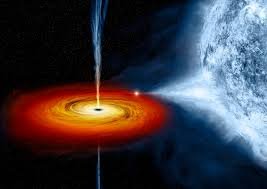Black holes are some of the most powerful and mysterious objects in the entire universe. They have no solid surface, no color, and no shape that we can see. Yet, they can control stars, planets, time, and even light. In this article, we explore what black holes are, how they form, and why science finds them so strange and fascinating.
What Is a Black Hole?
A black hole is a region in space where gravity is so strong that nothing can escape from it—not even light. Because light cannot come out, black holes look completely dark. Scientists discover them by observing how they affect nearby stars and space objects.
At the center of a black hole is a point called the singularity, where matter is squeezed into an extremely tiny space with infinite density.
How Do Black Holes Form?
Black holes form when very large stars run out of fuel.
This happens in three steps:
- A massive star collapses under its own gravity.
- The collapse creates a powerful explosion called a supernova.
- What remains is a super-dense core that becomes a black hole.
Only stars 10 times bigger than our Sun can form black holes. Smaller stars become white dwarfs or neutron stars instead.
Types of Black Holes
Scientists have discovered multiple kinds of black holes:
1. Stellar Black Holes
These are formed from collapsing stars and are the most common type.
2. Supermassive Black Holes
Found at the center of every galaxy, including the Milky Way.
They are millions or billions of times heavier than the Sun.
3. Intermediate Black Holes
Not too big, not too small—scientists believe they form when multiple stars collide.
4. Mini Black Holes
Theoretical small black holes that may have formed right after the Big Bang.
Why Are Black Holes So Strange?
1. They Bend Time
According to Einstein’s theory, black holes warp both space and time.
The closer you get to one, the slower time passes for you.
This phenomenon is called time dilation.
2. They Bend Light
A black hole’s gravity is so strong that it bends light around it.
This creates a glowing ring called the event horizon, the boundary beyond which nothing returns.
3. They Can Stretch Objects
A strange effect, known as spaghettification, occurs when something gets too close.
Gravity stretches the object into a long, thin shape—like spaghetti.
4. They Can Grow Forever
Black holes grow by eating:
• Gas
• Dust
• Stars
• Even other black holes
This makes them some of the largest structures in the universe.
How Do Scientists Study Black Holes If They Are Invisible?
Scientists use indirect methods, such as:
• Observing how stars move around them
• Detecting X-rays from material heating up near the event horizon
• Studying gravitational waves when black holes collide
• Using powerful telescopes to capture black hole shadows
In 2019, scientists took the first-ever image of a black hole’s shadow, proving these giants really exist.
Do Black Holes Destroy Everything?
Movies show black holes swallowing galaxies, but in reality, black holes do not go around “eating” everything.
They only affect objects that get very close to them.
Our solar system is too far from any dangerous black hole, so Earth is completely safe.
Could Black Holes Lead to Another Universe?
Some theories suggest black holes may act as tunnels to other universes or dimensions.
These ideas are still unproven but continue to fascinate scientists and space lovers.
Final Thoughts
Black holes are mysterious, powerful, and full of scientific secrets. They teach us about gravity, time, and the structure of the universe. Although invisible, their impact shapes galaxies and expands our understanding of reality.
